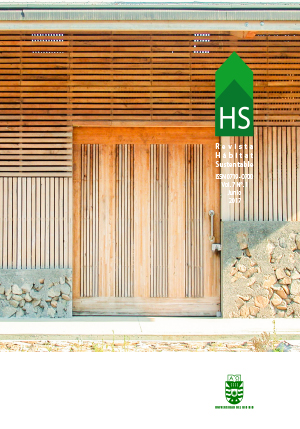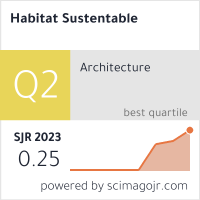El control adaptativo en instalaciones existentes y su potencial en el contexto del cambio climático.
DOI:
https://doi.org/10.22320/07190700.2017.07.02.01Palabras clave:
Confort adaptativo, confort adaptativo, cambio climático, demanda energética, temperatura de consignaResumen
En la actualidad, la mayoría de los edificios de oficinas tienen un elevado consumo energético provocado principalmente por el uso de los sistemas de HVAC, en los que se logra el confort térmico sin considerar las implicaciones energéticas. Los objetivos de la investigación que aquí se expone es reducir la demanda y consumo energético, manteniendo altos niveles de confort térmico adaptativo, en base a la aplicación de temperaturas de consigna adaptativas calculadas según la norma EN 15251, como también identificar el potencial de estos procedimientos en el contexto del cambio climático de los años 2020, 2050 y 2080. Para ello, se desarrolla una metodología que contempla fases de (1) recopilación de datos; (2) trabajo de campo –monitoreo de las temperaturas del edificio y realización de encuestas de confort térmico-; (3) validado del modelo de simulación, en base a temperatura, voto medio predictivo (PMV) y consumo energético; (4) simulaciones; y (5) obtención de resultados. Como aplicación del método se selecciona un edificio de reciente construcción en Sevilla (España) que cumple la normativa vigente. Los resultados muestran reducciones muy importantes en la demanda y consumo energético, con valores entre 52% y 63% y entre 51% y 61%, respectivamente, dependiendo del escenario climático analizado.
Descargas
Citas
ANSI/ASHRAE. ASHRAE Guideline 14-2014: Measurement of Energy, Demand, and Water Savings, 2014.
ASHRAE. Thermal Environmental Conditions for Human Occupancy. ANSI/ASHRAE Standard 55-2013, 2013.
BELCHER, Stephen; HACKER, Jacob y POWELL, Diana. Constructing design weather data for future climates. Building Services Engineering Research and Technology, 2005, vol. 1, pp. 49–61. doi: 10.1191/0143624405bt112oa.
CEN. ‘EN 15251: Indoor environmental input parameters for design and assessment of energy performance of buildings- addressing indoor air quality, thermal environment, lighting and acoustics’. Brussels: European Committee for Standardization, 2007.
EUROPEAN COMMISION. A policy framework for climate and energy in the period from 2020 to 2030. Brussels, 2014.
EUROPEAN COMMISSION. 20 20 by 2020 - Europe’s climate change opportunity. Brussels, 2008. Available at: http://eur-lex.europa.eu/legal-content/EN/TXT/PDF/?uri=CELEX:52008DC0030&from=EN.
FANGER, Povl Ole. Thermal Comfort. New York: McGraw Hill, 1970.
GOBIERNO DE ESPAÑA. Royal Decree 314/2006 approving the Technical Building Code (Real Decreto 314/2006, de 17 de marzo, por el que se aprueba el Código Técnico de la Edificación. Madrid, España: Imprenta Nacional del Boletín Oficial del Estado, 2006.
GOBIERNO DE ESPAÑA. Royal Decree 1027/2007 approving the Spanish Thermal Building Regulations (Real Decreto 1027/2007, de 20 de julio, por el que se aprueba el Reglamento de Instalaciones Termicas en los Edificios). Madrid, España: Imprenta Nacional del Boletín Oficial del Estado, 2007.
HOYT, Tyler; ARENS, Edward y ZHANG, Hui. Extending air temperature setpoints: Simulated energy savings and design considerations for new and retrofit buildings. Building and Environment, 2014, nº 88, pp. 89–96. doi: 10.1016/j.buildenv.2014.09.010.
JENTSCH, Mark; JAMES, Patrick; BOURIKAS, Leonidas y BAHAJ, AbuBakr. Transforming existing weather data for worldwide locations to enable energy and building performance simulation under future climates. Renewable Energy, 2013, vol. 55, pp. 514–524. doi: 10.1016/j.renene.2012.12.049.
KRAMER, Rick; MAAS, Marco; MARTENS, Marco; VAN SCHIJNDEL, Jos y SCHELLEN, Henk. Energy conservation in museums using different setpoint strategies: A case study for a state-of-the-art museum using building simulations. Applied Energy, 2015, vol. 158, pp. 446–458. doi: 10.1016/j.apenergy.2015.08.044.
VAN DER LINDEN, Kees; BOERSTRA, Atze; RAUE, Arjen; KURVERS, Stanley y DE DEAR, Richard. Adaptive temperature limits: A new guideline in the Netherlands: A new approach for the assessment of building performance with respect to thermal indoor climate. Energy and Buildings, 2006, 38(1), pp. 8–17. doi: 10.1016/j.enbuild.2005.02.008.
LUCON, Oswaldo; ÜRGE-VORSATZ, Diana; ZAIN AHMED, Azni; AKBARI, Hashem; BERTOLDI, Paolo; CABEZA, Luisa; EYRE, Nicholas; GADGIL, Ashok; HARVEY, Danny; JIANG, Yi; LIPHOTO, Enoch; MIRASGEDIS, Sevastianos; MURAKAMI, Shuzo; PARIKH, Jyoti; PYKE, Christopher y VILARIÑO, Maria Virginia. Buildings. En: Climate Change 2014: Mitigation of Climate Change. Contribution of Working Group III to the Fifth Assessment Report of the Intergovernmental Panel on Climate Change. Brussels: European Commision, 2014, pp. 1–66. doi: 10.2753/JES1097-203X330403.
MCCARTNEY, Kathryn y NICOL, Fergus. Developing an adaptive control algorithm for Europe. Energy and Buildings, 2002, vol. 34, pp. 623–635.
RUBIO-BELLIDO, Carlos; PÉREZ-FARGALLO, Alexis y PULIDO-ARCAS, Jesús Alberto. Optimization of annual energy demand in office buildings under the influence of climate change in Chile. Energy, 2016, vol. 114, pp. 569–585. doi: 10.1016/j.energy.2016.08.021.
RUBIO-BELLIDO, Carlos; PULIDO-ARCAS, Jesús Alberto y URETA-GRAGERA, María. Aplicabilidad de estrategias genéricas de diseño pasivo en edificaciones bajo la influencia del cambio climático en Concepción y Santiago, Chile. Habitat Sustentable, 2015, vol. 5(2), pp. 32–41.
SÁNCHEZ-GARCÍA, Daniel; RUBIO-BELLIDO, Carlos; GUEVARA-GARCÍA, Francisco Javier y CANIVELL, Jacinto. The influence of climate change in extant dwellings through adaptive comfort point of view. En: Proceedings of the 3rd International Congress on Sustainable Construction and Eco-Efficient Solutions. Sevilla: Universidad de Sevilla, 2017, pp. 532–544.
SÁNCHEZ-GARCÍA, Daniel; SÁNCHEZ-GUEVARA SÁNCHEZ, Carmen y RUBIO-BELLIDO, Carlos. El enfoque adaptativo del confort térmico en Sevilla = The adaptive approach to thermal comfort in Seville. Anales de Edificación, 2016, vol. 2(1), p. 38-48. doi: 10.20868/ade.2016.3197.
SÁNCHEZ-GUEVARA SÁNCHEZ, Carmen; MAVROGIANNI, Anna y NEILA GONZÁLEZ, Francisco Javier. On the minimal thermal habitability conditions in low income dwellings in Spain for a new definition of fuel poverty. Building and Environment, 2016, vol. 114, pp. 344–356. doi: 10.1016/j.buildenv.2016.12.029.
SPYROPOULOS, Giorgios y BALARAS, Constantinos. Energy consumption and the potential of energy savings in Hellenic office buildings used as bank branches - A case study’, Energy and Buildings, 2011, vol. 43, nº4, pp. 770–778. doi: 10.1016/j.enbuild.2010.12.015.
TUMINI, Irina y RUBIO-BELLIDO, Carlos. Measuring Climate Change Impact on Urban Microclimate: A Case Study of Concepción. Procedia Engineering, 2016, vol. 161, pp. 2290–2296. doi: 10.1016/j.proeng.2016.08.830.
Descargas
Publicado
Cómo citar
Número
Sección
Licencia
El contenido de los artículos que se publican en cada número de Hábitat Sustentable, es responsabilidad exclusiva de los autores y no representan necesariamente el pensamiento ni comprometen la opinión de la Universidad del Bío-Bío.
Los autores/as conservarán sus derechos de autor y garantizarán a la revista el derecho de primera publicación de su obra, el cuál estará simultáneamente sujeto a la Licencia de Reconocimiento de Creative Commons CC BY-SA que permite a otros compartir-copiar, transformar o crear nuevo material a partir de esta obra con fines no comerciales, siempre y cuando se reconozcan la autoría y la primera publicación en esta revista, y sus nuevas creaciones estén bajo una licencia con los mismos términos.











 Programa de Información Científica/Concurso Fondos de Publicación de Revistas Científicas 2018/ Proyecto Mejoramiento de Visibilidad de Revistas UBB (Código:FP180007)
Programa de Información Científica/Concurso Fondos de Publicación de Revistas Científicas 2018/ Proyecto Mejoramiento de Visibilidad de Revistas UBB (Código:FP180007) 





